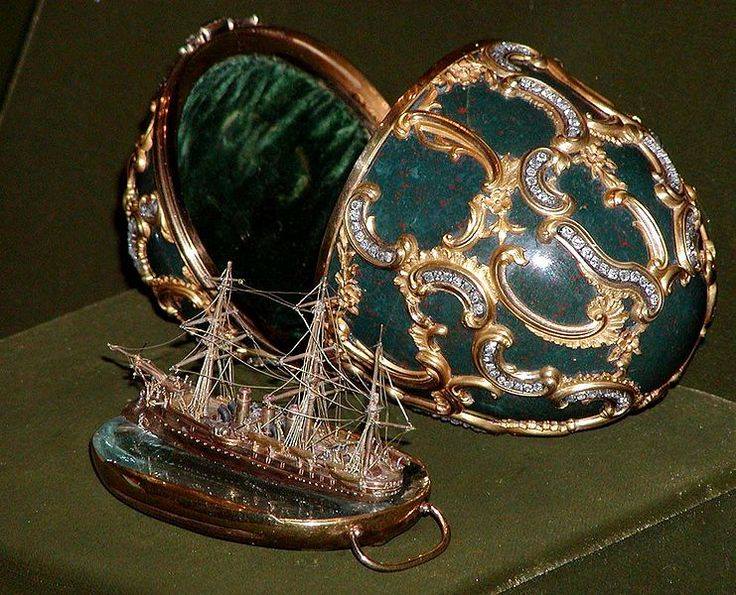The Memory of Azov Faberge Egg
The Memory of Azov original Faberge egg is one of the jeweled Easter eggs created under the supervision of Peter Carl Faberge for Tsar Alexander III. It is one of the authentic Faberge eggs that doesn’t have a complicated history of discovery, loss, and ownership. The egg never went up for auction.
Origins of the Memory of Azov Egg
Before its creation
Alexander III ordered the egg creation to serve as a gift. He intended to present the egg to his wife, Maria Feodorovna, on Easter day in 1891. The creation of the egg served as a commemoration of the voyage made by Tsarevtich Nicholas and Grand Duke George of Russia. The journey took place on the Pamiat Azova in 1890, where the two set sail towards the Far East. The original point of the trip was by the suggestion of their parents. It was to expand the outlook of the future Tsar and his brother.
At the time of the voyage, Grand Duke George was suffering from tuberculosis, with the sailing only making it worse. Furthermore, while in Japan, there was a failed assassination attempt on Tsarevitch Nicholas (the Otsu incident). Faberge started working on the egg before the assassination attempt took place. It may be for that reason that Maria was never particularly fond of it.
Description of the egg
The egg itself is cut and carved from a single chunk of bloodstone or better known as heliotrope jasper. The design of the egg takes inspiration from the Louis XV style. It comprises Rocco scrolls superimposed onto the egg in a gold pattern, along with diamond and gold flowers. A drop ruby is set within the broad flute gold bezel and the clasp is completed with two diamonds. The interior of the egg is lined with a spectacular green velvet.
When you open the egg, it reveals a crafted miniature version of the aforementioned Pamiat Azova (Memory of Azov) Imperial Russian Navy Cruiser. The ship is crafted from red and yellow platinum and gold. It has small diamonds set as windows. The boat is set on a single piece of aquamarine, which represents water. The name of the ship, “Azov,” is carved into the ship’s stern. The aquamarine plate comes with a golden frame. Allowing the model to be looped and removed from the egg. Altogether, the egg is made from bloodstone, ruby, gold, diamond, aquamarine, and platinum. It is 3.7 inches in height, with an undetermined width, and unknown weight.
Who Created the the Memory of Azov Egg
Peter Carl Faberge was the one who received the order of creating the egg. However, the work masters Michael Perkin and Yuri Nicolai were the ones who physically crafted this real Faberge egg and completed it in Faberge’s workshop.
Michael Perkin created the egg at 1891. The same year the egg’s original recipient, Alexander III, gifted it to his wife, Maria Feodorovna. The egg was a present for that year’s Easter. This was after Faberge was appointed as a jeweler in service of the Tsar. At this point, the annual Faberge egg gift had become a tradition.
Where Can You Find the Egg Today?
We assume that the egg arrived at Gatchina Place. 1-2 years after Tsarina Maria received the egg. It would have likely remained there until 1917, at which point the Bolshevik revolution took place. The egg went along with the rest of the Imperial Faberge eggs, to the Armoury Place of the Kremlin. This is where the egg remains to this day.
As a result, the egg has never auctioned and has no pricing history. Combined with the fact that the egg is one of the lesser-known Faberge eggs. Suggests it would be towards the lower price valuation of common Faberge eggs. Regardless, this amount could still be anywhere from two to $33 million dollars.
For those that wish to see the Authentic Memory of Azov Faberge egg. You can go and visit it in person today. With tickets for the Armoury Museum being available for purchase. At the museum, you can also see a variety of other Faberge eggs. Including the majority of the imperial eggs that were seized during the 1917 bloody revolution. The Kremlin Armoury is home to the most extensive single collection of Faberge eggs. It is the institute with the largest collection of them.
My name is Sasha, I’m a father of two. Work in the tech industry. For fun I am running a small business in addition to that, sometimes I write and edit content regarding topics that interest me like: entertainment, tech, finance and art.


Leave a Reply
You must be logged in to post a comment.